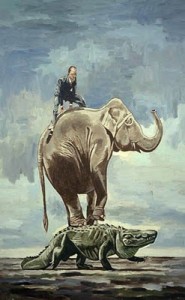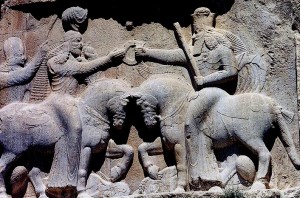Text by Sohrab Saadat Ladjevardi
Almost every month I find out about the existence of an Iranian musician or band in or outside of Iran. Since beginning of last year I have been aware of an new Iranian music scene which I would like to call the Iranian New Wave MUSIC (INWM). Most of these Iranian musicians who represent INWM either live and perform in Europe, in countries such as Germany, Austria, Switzerland, France, England, Holland, Sweden, Spain, Belgium and in the US, or in Iran hiding in their homes. Performing their music at private parties or at European embassies in Tehran. All of them have one thing in common: searching for their own voices or identities. Like their foreign counterparts they want to contribute to the “pluralistic-modern world of music” and be a part of it without forgetting their Iranian roots.
Most of these musicians are into jazz, blues, reggae, electronica, indie-rock, heavy metal, Flamenco, Indian classical music, Latin music, Iranian folk music, Western contemporary and classical music. They either like to experiment with their traditional instruments, such as tar, santour, dombak, ney and daf, hooking them up to a lap-top in order to create sounds which are beyond of the original sound of that specific instrument. Or they play foreign instruments from the beginning.
For example, Manhattan’s Alan Kushan, who’s my favorite santur player and a pioneer of the “modern” santur. He plays the santur “inside and outside” than any other santur player. In order to play his original music he invented a chromatic santur which can be played in an Iranian folk music or in a Western music set up. Another good example is the Brooklyn’s troubadour Mohsen Namjoo who is trying to combine the blues with Iranian folk music. He plays his setar like a blues guitarist and sings in a very unconventional bluesy way. Than the Iranian sisters Abjeez from Sweden fuses reggae rhythm with Iranian 6/8 rhythm singing mostly in Farsi. Vienna’s jazz guitarist Mahan Mirarab fusing jazz with Iranian folk music.
Other bands and musicians of interest are Yellow Dogs, 127, Kiosk, Susan Deyhim, Hypernova, Rana Farhan, Fared Shafinury, Haale, Mehran, Kaveh Haghtalab, Aida Shahghasemi, Hafez Modirzadeh, Katayoun Goudarzi and many more. And of course my band SoSaLa. All of them are featured in DooBeeDoo and located in the US.
Like Kushan Iran’s classical/folk vocalist and maestro Mohammad-Reza Shajarian has been the brain of many inventions of new Iranian classical music instruments, such as the kereshmeh, the saboo, the saghar, the sorahi, and the tondar. So not only the music itself has been changing but also the instruments which make this music. But there are female traditional musicians and singers like Sima Bina who pursuit their Iranian folk music career outside of Iran. Because Iranian women are not allowed to sing in public.
I believe music and everyday life go together. Since Iran’s Islamic revolution in 1979 Iran’s music culture has deteriorated. Iranians are not allowed to enjoy music the way they want to. Music lovers and musicians lost touch to each other. But some time ago, when I don’t know exactly, the INWM started to make a change in people’s lives. It’s happening now!!! INWM keeps people alive especially Iran’s youth. It makes them think about their lives and keep her identity. This new development in the Iranian music scene can’t be stopped. The time has come that young and older musicians unite and work out a platform on which conservative and progressive musicians can collaborate and create. Singing and playing the music of a free Iran.
One of Iran’s INWM bands is the trio Sehrang, meaning tri-colored in Farsi, comprised of one female singer and two male instrumentalists – Golnar Shahyar (vocals), Mahan Mirarab (guitar) and Shayan Fathi (drums & percussion) – who all have been living in Europe for a while. Mirarab and Shahyar live in Vienna and Fathi in Madrid.
They all share the same vision of making music and their love for jazz. Jazz gives them the freedom to do whatever they want to do. No pressure, limitations and restrictions by the Iranian officials! They don’t have to be afraid of how other people think of their music. The group’s sound is jazzy but still rooted in Iranian folk music. Shahyar’s voice speaks on behalf of Iran’s oppressed women. The lyrics are written by her or taken from classical Iranian poetry.
Sehrang’s new album will be released in December. Here is a promo video of it:



